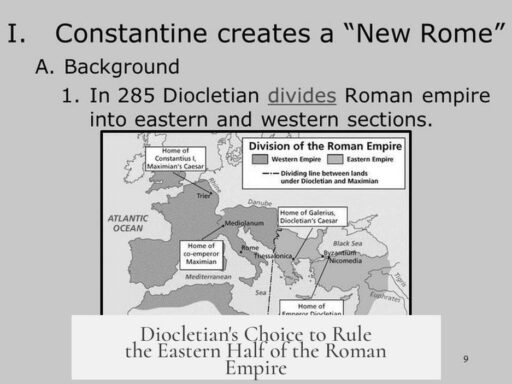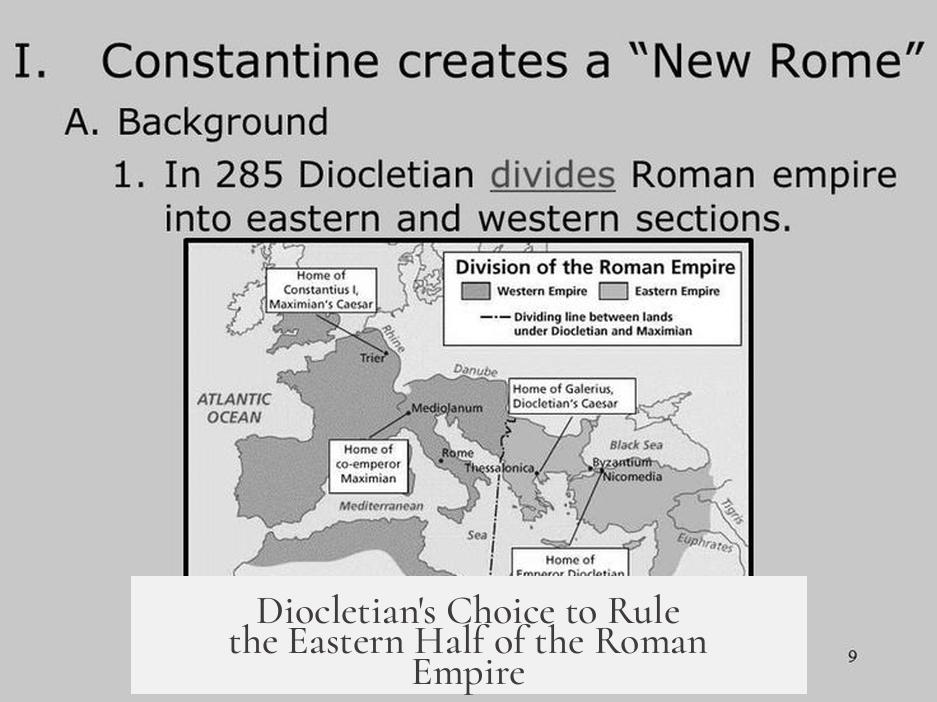Emperor Diocletian chose to rule over the eastern half of the Roman Empire primarily due to strategic priorities, especially the need to manage the Persian frontier and secure Egypt’s wealth. His decision reflected a focus on regions critical for the empire’s stability and prosperity rather than a formal division between East and West.
At Diocletian’s time, the Roman Empire was not formally divided. The concept of separate Eastern and Western Empires did not exist as it might appear to modern historians. Instead, imperial authority was shared through the Tetrarchy system, which Diocletian introduced. This system appointed two senior emperors called *Augusti* and two junior emperors called *Caesares*, distributing power across key regions. Each ruler had near-complete authority within his domain, allowing the emperors to address multiple crises simultaneously. Power was mobile, not fixed in a single capital, as emperors frequently traveled to confront threats directly.
Diocletian, as the senior Augustus, took personal responsibility for the eastern territories. This decision aligned with the significant challenges along the Persian frontier, a region that required constant military attention and diplomatic engagement. More importantly, Egypt’s role as a vital supplier of grain and wealth made its protection crucial. Egypt’s economic importance provided a more stable base for power compared to Rome, whose significance had declined due to its consumption of resources rather than production.
Culturally and economically, the East boasted a longer tradition of urbanization, wealth, and civilization, factors that added to its appeal as a power base. This interest was pragmatic rather than symbolic; the East’s cities and trade routes represented tangible advantages for imperial rule.
- The Roman Empire was not formally divided in Diocletian’s era.
- Diocletian’s Tetrarchy distributed power among multiple emperors to handle crises effectively.
- Diocletian prioritized the eastern frontier and Egypt due to their strategic and economic significance.
- Control of Egypt provided a secure and resource-rich base of power compared to Rome.
- The East held cultural and economic prestige beyond that of the declining Western regions.
Why Did Emperor Diocletian Choose to Rule Over the Eastern Half of the Empire Over the West?
Diocletian chose to rule the eastern half because it secured the empire’s most vital and resource-rich regions, especially the Persian frontier and Egypt, which offered greater stability and wealth compared to the more volatile west centered on Rome. Simple, right? But let’s break it down, because the story is far richer than just picking the east for a sunlit view.
First, imagine the Roman Empire like a giant pizza—only it’s a pizza so big no one guy can eat it all in one sitting. At Diocletian’s time, the empire wasn’t formally chopped into east and west slices. That division? It’s a modern invention shaped by history books and hindsight. Back then, they shared power rather than split land like siblings quarrelling over the last slice.
“Basically, the Roman Empire was not divided; no one at this date thought in terms of an Eastern or Western empire…”
Diocletian’s genius move was creating the Tetrarchy, a system where the empire ran under multiple emperors—two senior ones called Augusti and two juniors called Caesares. This wasn’t splitting the empire territorially, but sharing imperial power in a way that allowed rulers to be near action hotspots simultaneously. Effective crisis management for a vast empire.
Instead of one guy juggling all the flaming swords, you have four folks each handling their own swords in different rings. This setup allowed the empire’s power to travel wherever an emperor was rather than being stuck in its traditional capital, Rome.
“The primary reason for creating multiple emperors was so that the emperor could effectively be in several places at once, dealing with multiple crises…”
Now the big question: why did Diocletian, the lead Augustus, decide to govern the eastern half? It boils down to what really matters—security and resources. The eastern territories faced the Persian empire, a perennial thorn in Rome’s, uh, side. Protecting this front was critical. And let’s not forget Egypt. It was like the Roman Empire’s personal cash cow, rich in grain and resources that kept the whole system fed and wealthy.
Rome in the west, glorious as it was, had largely become a resource consumer, eating up wealth without producing much new treasure. Controlling Egypt and the eastern provinces gave Diocletian real economic power and influence. Plus, the eastern regions boasted a deeper cultural heritage, dense urban development, and substantial economic prestige—factors that made it both a strategic and dignified choice.
“Control of Egypt was a much more secure source of power than control of Rome, which consumed resources rather than producing them.”
“The East had the longest traditions of culture, cities and civilisation.”
For context, envision Diocletian as the senior leader focusing on where real muscle and assets were. His colleague, Maximian, was the Augustus overseeing the west and defending the Rhine and Danube frontiers. Both emperors had their tough gigs, but Diocletian’s grip on the east was a calculated decision of practical governance rather than a mere title grab.
This approach underlines an important leadership lesson—for massive empires or organizations alike: positioning yourself where the vital resources flow is key to effective control. Diocletian didn’t pick the east just because of charm or exotic landscapes. He did it because it was the empire’s economic engine and its security linchpin.
So, what does this mean for us today? When facing complex challenges, spreading leadership duties close to the action, rather than centralizing power in one ‘capital,’ can yield better responses and stronger control. Diocletian’s Tetrarchy system might just be ancient wisdom for modern multitasking governance.
In summary, Diocletian’s eastern reign reflects a mix of strategic prioritization, resource management, and frontier defense. The man wasn’t just sitting pretty on the warm shores of the Mediterranean while the west struggled—he was securing the empire’s backbone, ensuring its longevity amid a turbulent era.
Could Diocletian have handled things differently? Maybe. But history shows that his choice helped delay the inevitable fall and fragmentation, particularly in the east, which had more endurance. Next time someone claims Diocletian was just splitting the empire for convenience, you’ve got the full picture: a clever power-sharing scheme driven by geography, economics, and politics.
Want to dive deeper? Look at how the Tetrarchy’s balanced power approach compares to modern federal systems. Fascinating stuff. And this understanding might just give you the upper hand in understanding how empires and big systems survive—and thrive—when they share leadership strategically.




